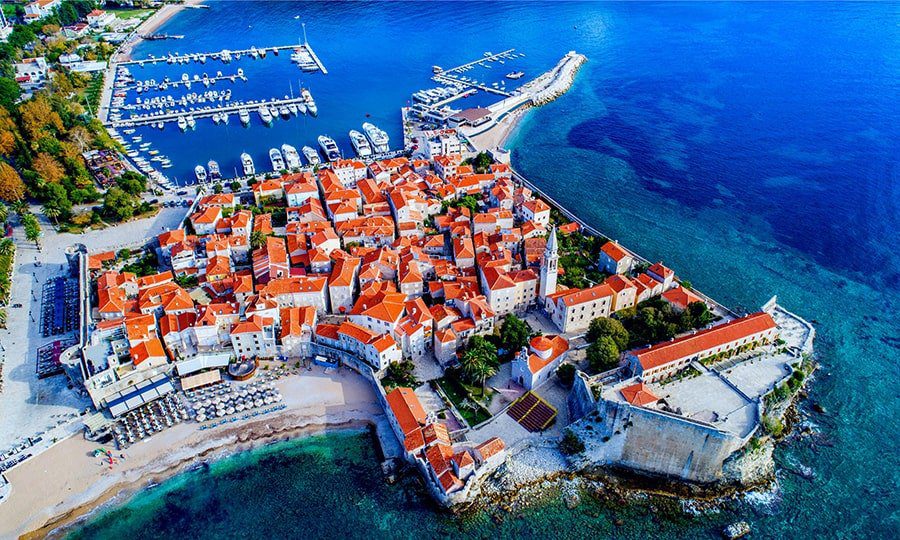Budva is not only positioning itself but indeed is the jewel of coastal Montenegro – culturally, historically, touristically, and aesthetically. The hallmark of this place is the natural beauty of landscapes, crowned with lush greenery and deep aquamarine, against which the capillaries of ancient heavy or, on the contrary, surprisingly fragile buildings shine even brighter. Visiting this city cannot leave you indifferent – these seemingly drawn city pages harmonize wonderfully with the mood of every person.
Citadel
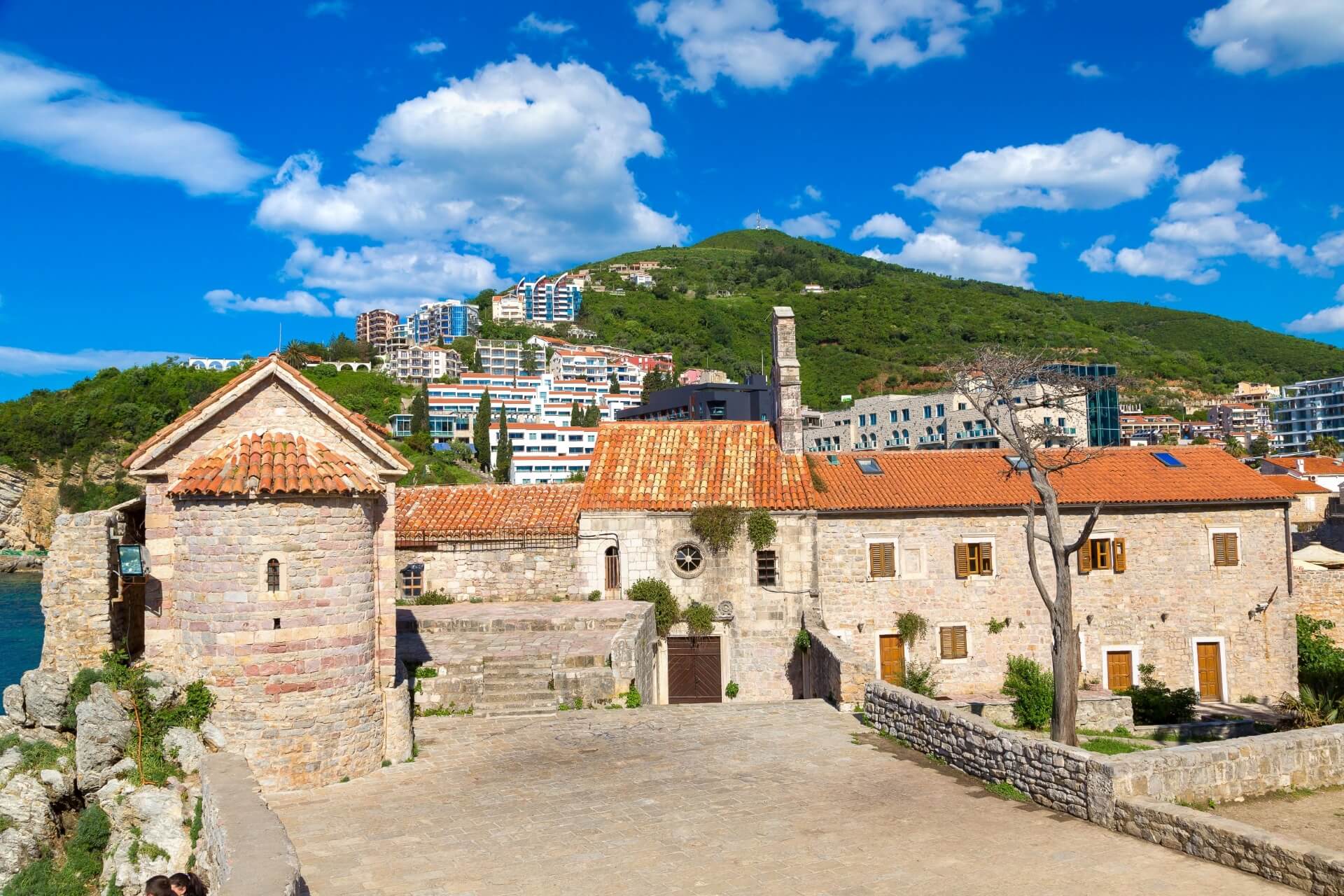
The massive walls of the fortress, built in the name of St. Mary, rise like a stone monolith above the rugged coastline of Budva – they have stood for more than a thousand years, built to protect against warlike Turks and completed by inspired Venetian masters who brought a barely noticeable Mediterranean color to this place. Visiting this ancient building is part of most walking tours around the city, welcoming guests from nine in the morning until eight in the evening.
Visiting the Citadel can be interesting not only to history enthusiasts and romantically inclined individuals but also to lovers of picturesque views from the stone walls – both urban panoramas and beautiful landscapes centered around the sea. Also of interest are hidden attractions, such as a thin bas-relief carved on the wall opposite the doors leading to the library.
The pair of intricately depicted fish, their tails entwined, have their own story. Visiting the Citadel will not be an expensive pastime – the approximate ticket price rarely exceeds two euros, but it is worth remembering that you will need to provide identification documents. An additional fee may be required to visit the museum building – one of the components of the Citadel, but whether to visit it or not depends on the guests themselves.
Library
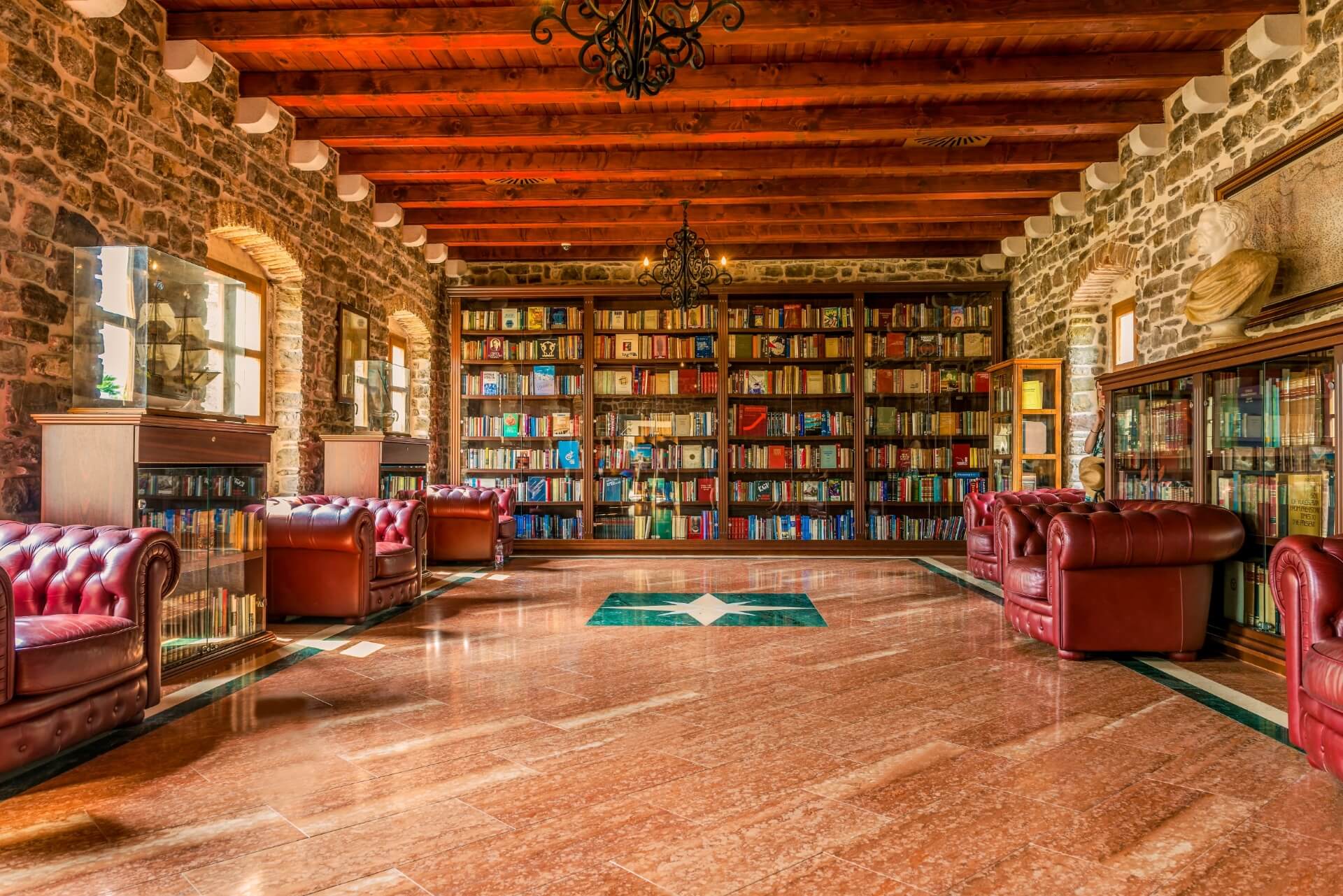
The Budva Library, or the Old Library as it is also called, is an impressive architectural ensemble both in terms of interior decoration elements and external decoration, which clearly feels Scandinavian motifs. Today the library is located in the Zeta Film building and is only part of a large complex that also includes an art gallery and an archaeological museum.
The library itself is a work of art. Many tourists come here just for luxurious backgrounds for photos – photography is allowed – and this luxury is perfectly felt in the antique decoration elements. Local residents, however, more often use it for its intended purpose, as well as a center for various scientific conferences, seminars, and other events. The center for the restoration of ancient epistolary monuments is also of certain interest.
The Old Library is closed only on Sundays, on other days its hospitable rooms are open from eight in the morning. However, it is better to check the schedule in advance. Entrance to the library is free, as is being in all its rooms. On the other hand, the library is part of the Citadel complex, and if the walk plan includes something other than the library itself, you will have to pay for entrance.
Promenade
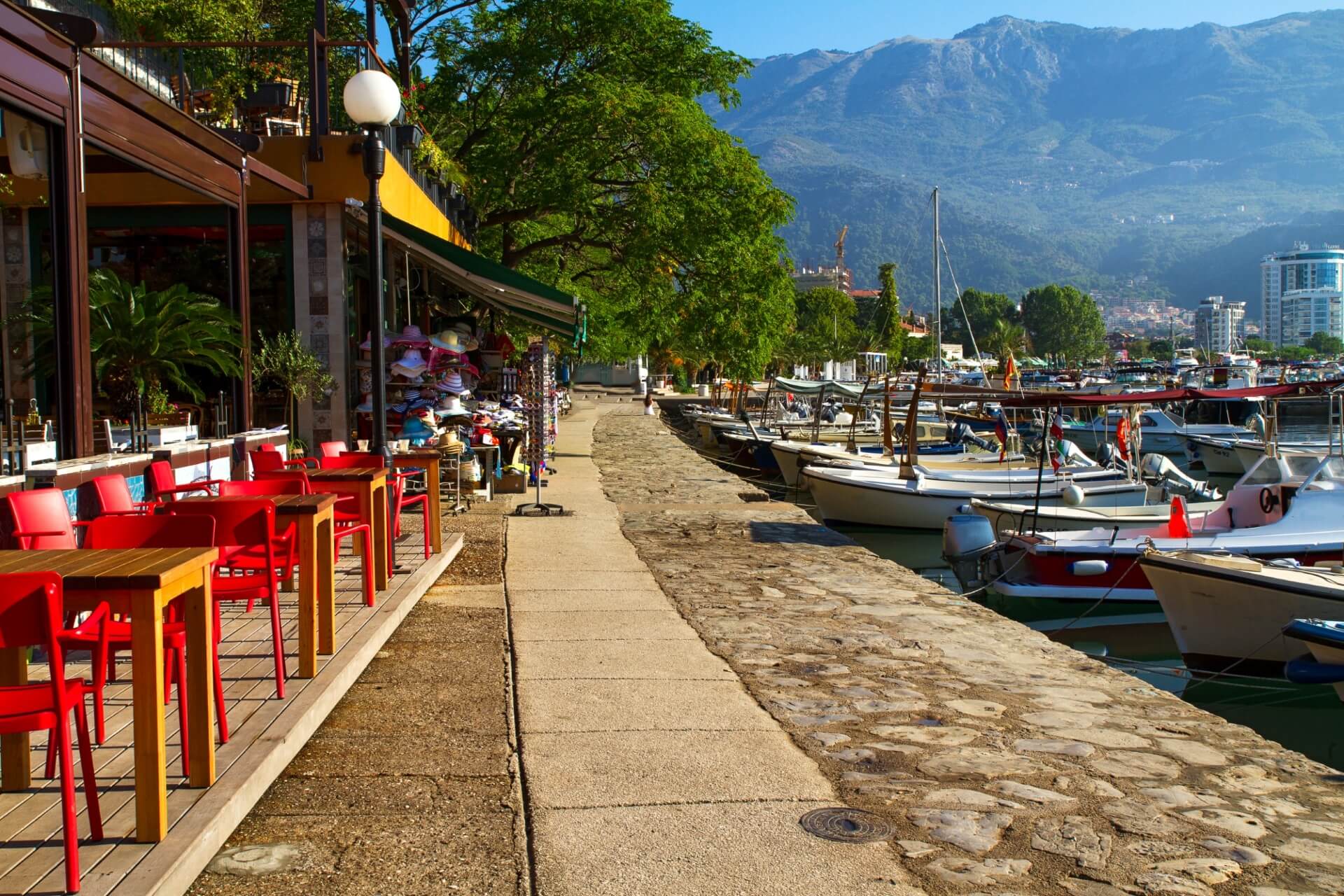
A favorite place for walks for locals and tourists alike, the Promenade is especially picturesque. It runs along the entire coast from the Old Town to the outskirts of the city. Spreading palms surround the wide pedestrian street on both sides.
Rows of restaurants, shops, and cafes line along it. In the distance, picturesque mountains and St. Nicholas Island can be seen. It is especially lively here in the evening hours when the daytime heat subsides. One can endlessly admire the sea in the rays of the setting sun, the white yachts, and boats by the shore. The coastal part of the promenade is separated from the water by a parapet.
Velvety lawns, bordered with fringes of bright flowers, please the eye. You can spend the evening in one of the open cafes against the backdrop of sea landscapes. From here, excursions are ordered, and a boat (5€) sets off to St. Nicholas Island or the luxurious Sveti Stefan peninsula.
The boat runs hourly back and forth. Fishing enthusiasts can rent a boat and fish in specially designated places. In the evening, the music of discos plays, and the inhabitants of the local hotels have fun. Fans of leisurely walks stroll here until midnight.
Podmaine Monastery
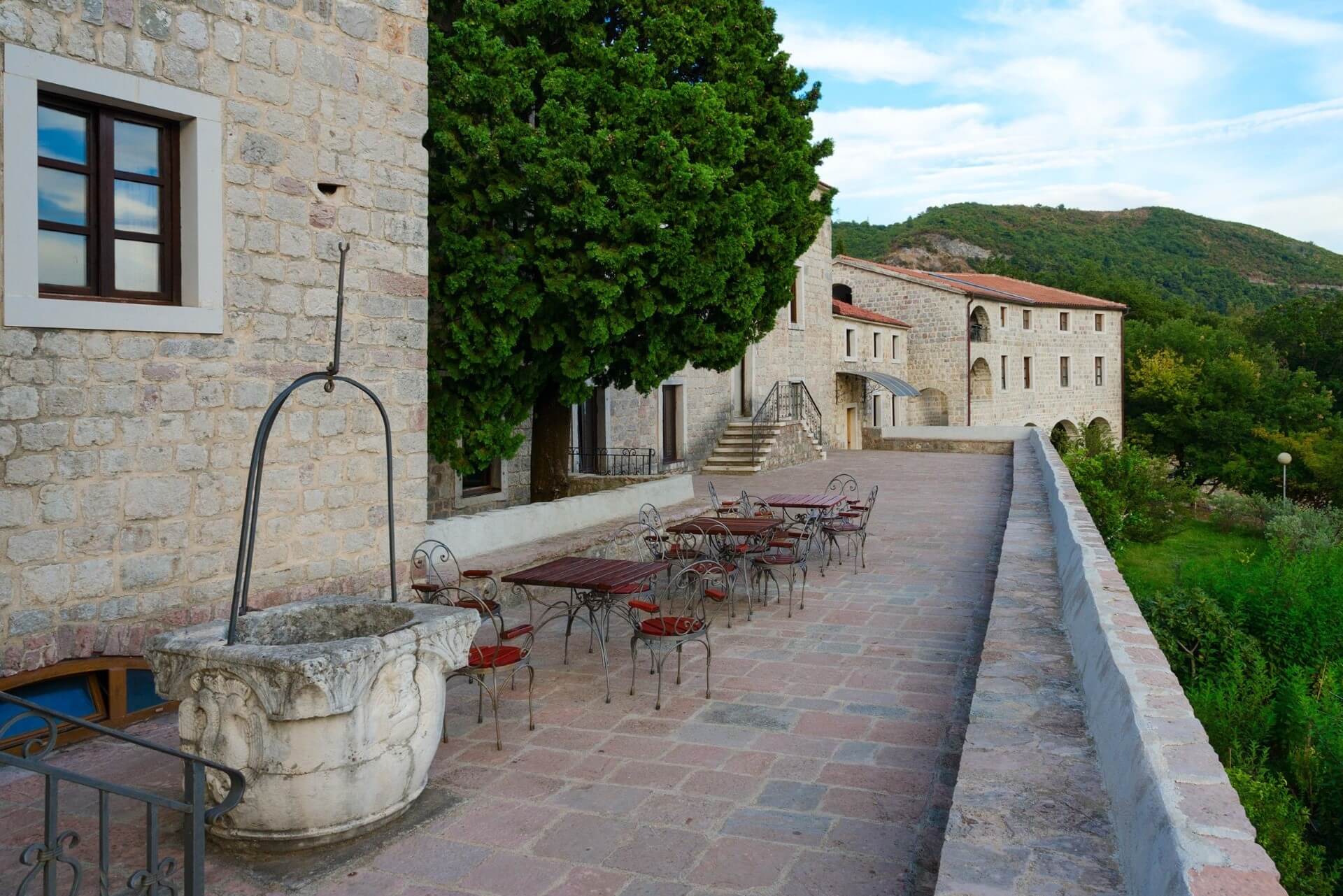
Podostrog, or as it is officially called, the Podmaine Monastery, is a rather peculiar architectural ensemble located about two kilometers from Budva, away from the tourist-filled streets but very close to the warm sea breezes. The Podmaine Monastery has a long history filled with bloody and pathetic pages, but the appearance of this place least of all speaks of this – the light walls are completely bare, without plaster and gold, the same light reflections on the tile roofs, and just a few buildings that make up this monastic complex.
Perhaps the most interest for tourists far from history and religious disputes may be the visit to the Small Dormition Church, whose building fully corresponds to its name. The entire church seems to be just one cell rising above the ground, but in reality, it rises above a real underground temple, whose frescoes had to be restored after a strong earthquake.
Visiting the Podmaine Monastery is best started as early as possible in the morning, before the sun gets too hot. You can get here on foot – just follow the signs that are placed throughout the city, but it should also be noted that these signs will confidently suggest climbing higher up the slope, so such a walk can be tiring. A taxi ride can cost six euros or more.
Church of the Holy Trinity
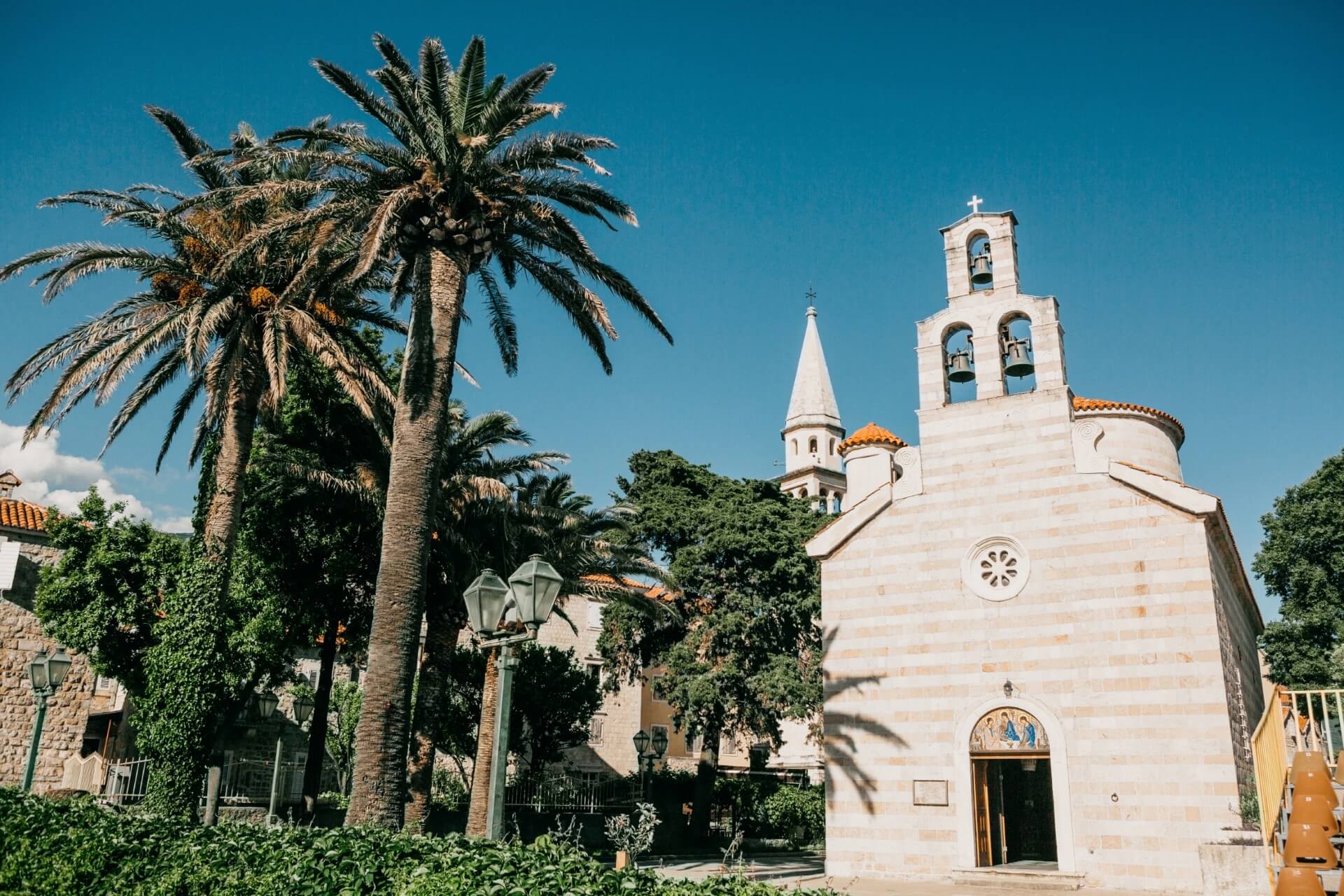
In Budva’s Old Town, there are enough architectural ensembles with centuries-old history and names inscribed in the ages, but the square in front of the Church of the Holy Trinity is always filled with people, despite most of these people not being true believers, and the church itself should be called rather young, especially against the background of other buildings in this area of the city. But be that as it may, it is this church that continues to attract attention.
This place is a kind of crossroads. Here meet baroque motifs and elements more characteristic of the Byzantine style with its tendency to high vaults and large domes. But here also meet echoes of past centuries – surprisingly clear echoes, for example, a quite accurate reconstruction of the famous icon of the same name by Andrei Rublev. The temple itself is almost an exact copy of another architectural structure – the Assumption Cathedral of Podgorica.
It is precisely its dissimilarity to classic Orthodox churches that attracts the Church of the Holy Trinity, at least that is how most tourists explain their interest, who also could not pass by the walls made of white and red stone and ancient fragments of wall paintings.
Budva Ballerina
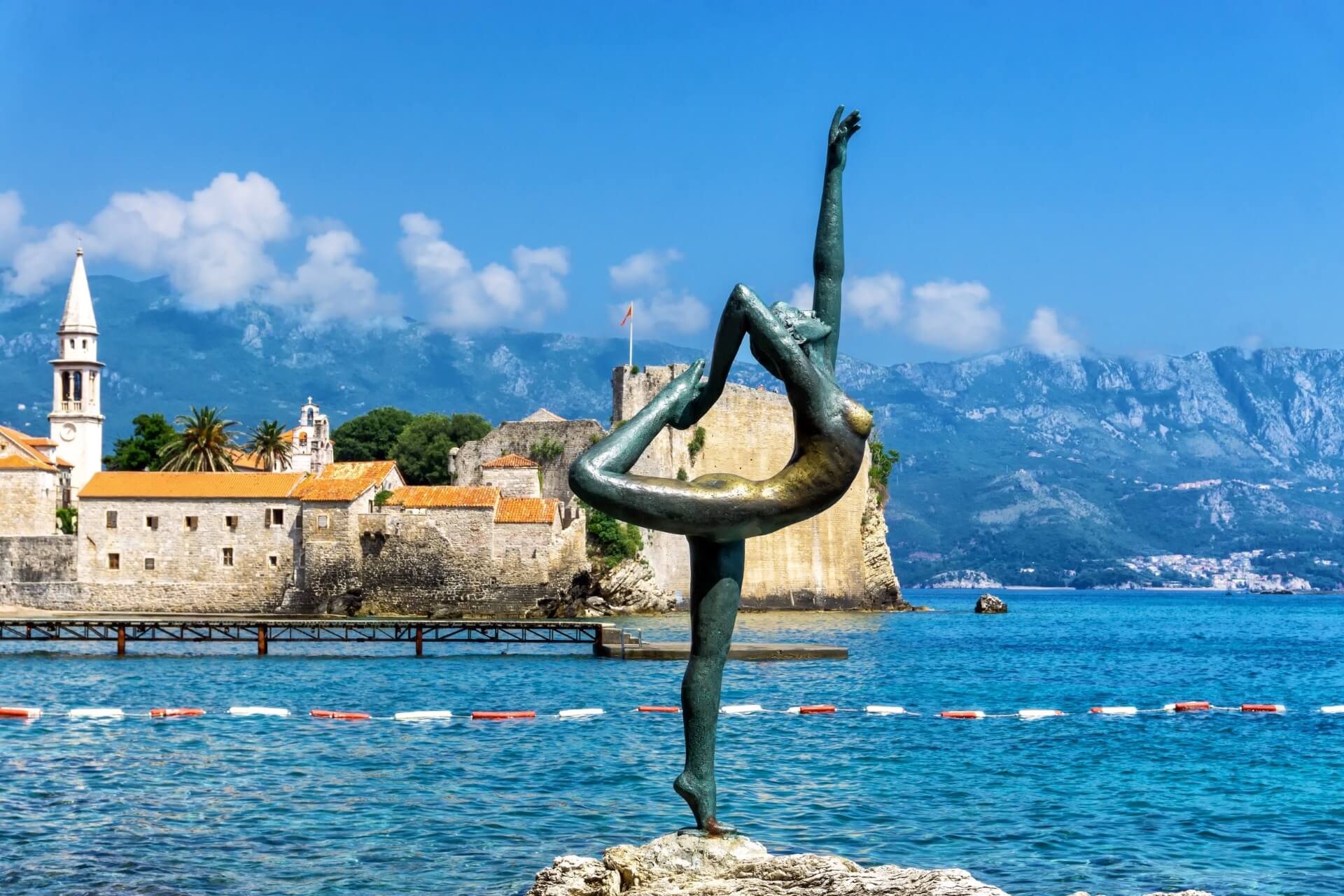
The graceful bronze figure of a naked girl, absorbed in looking at the sea, frozen in a dance movement, has long become one of the most popular “idols” of the city. By its mood, the “Ballerina of Budva” resembles the stories of Grin about scarlet sails, being just as detached and disconnected from reality – nothing is known about this bronze beauty – neither how long she has been peering into the shimmering reflections on the sea surface, nor who created her or why.
Each person willing to share their version of the story comes up with something a bit different, but almost always in somewhat sad tones. Meeting the mysterious Dancer is not as impossible as the prospect of learning the real story of the bronze beauty. In this respect, the real lucky ones are the guests of the Avala hotel, as it is behind it that the boulder on which the statue is installed is located.
Other guests of the city will have to make their way from the promenade towards the old part of the city, bravely ignoring the seemingly postcard-perfect Richard’s Head beach. It is worth closely examining the surrounding buildings – the required one is a new building, diving under the concrete canopy of which one can exit to a narrow strip of a path clinging to sheer cliffs. At the end of this path are Mogren Beaches, where the sought-after monument is located.
Mogren Fortress
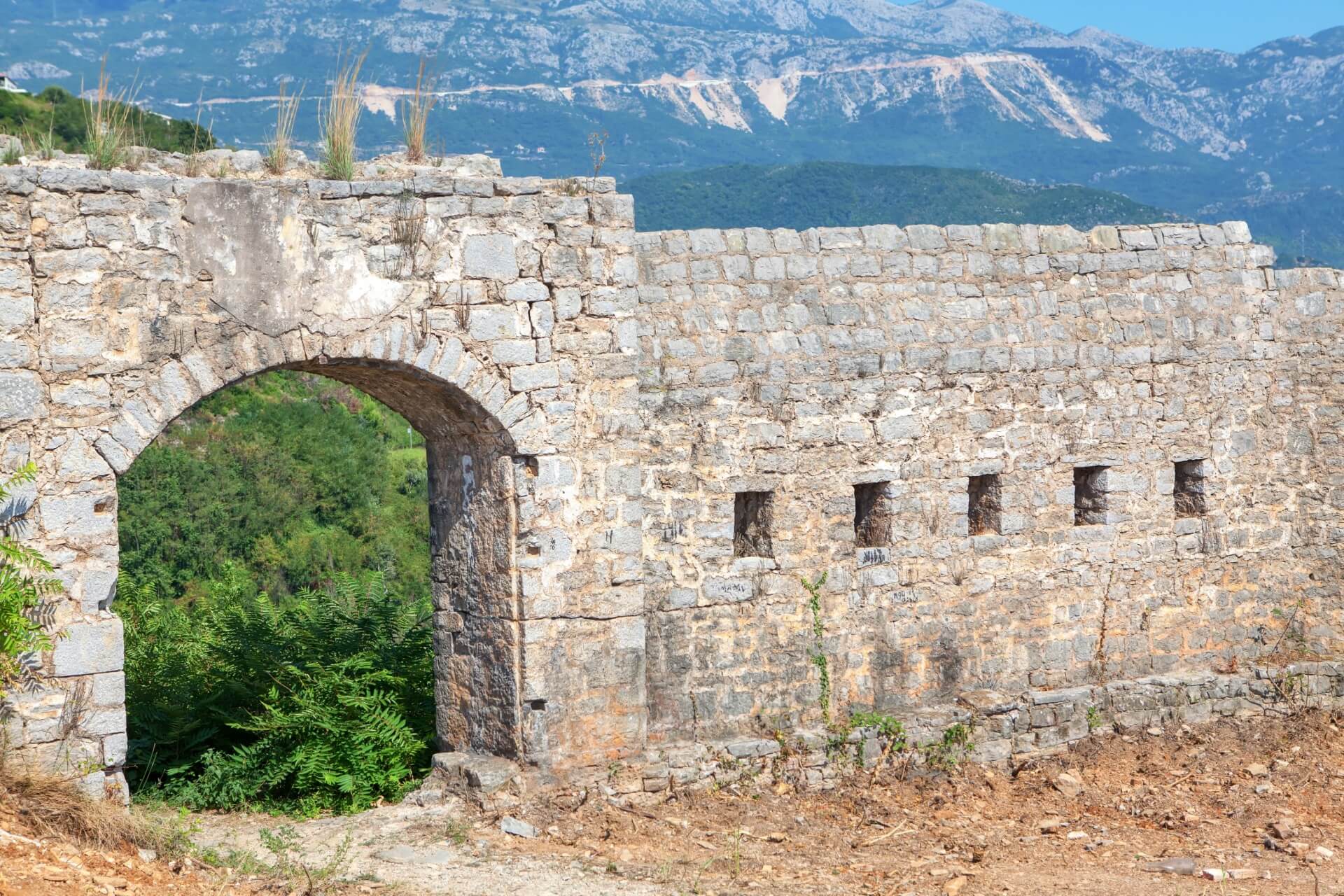
The fortress walls of Mogren were once the most formidable structure on the entire coast of Budva. The monolithic stone structures became part of the sharp stone cape jutting forward, and the high watchtowers at the corners of the improvised rectangle completed the picture. Today only fragments remain of the fortress walls, but even they are slowly disappearing under a green carpet. But there is a charm in this too – seclusion and the opportunity to take a series of beautiful shots.
Today, visiting the fortress does not require contacting a travel agency or buying tickets – official excursions are not conducted here, so everything depends only on the personal enthusiasm of each individual. The ruins of Mogren are located about a kilometer from Budva between two picturesque beach areas – Jaz and Mogren – on a fairly high hill. Previously, there were several walking routes by which one could reach the fortress, but today the path leading from Mogren-2 beach has become difficult to pass, so it is better to walk along the Adriatic highway.
The walk along a fairly convenient sidewalk will take about fifteen minutes, then a tunnel begins, at which there is a sign “Tvrdava Mogren”. It is here that you should turn left – onto a dirt road, which is usually heavily washed out after rains, so it is very important to carefully choose the day and time for such a walk. The road constantly goes up and winds among lush greenery until it finally reaches the Mogren fortress.
Mogren Beach
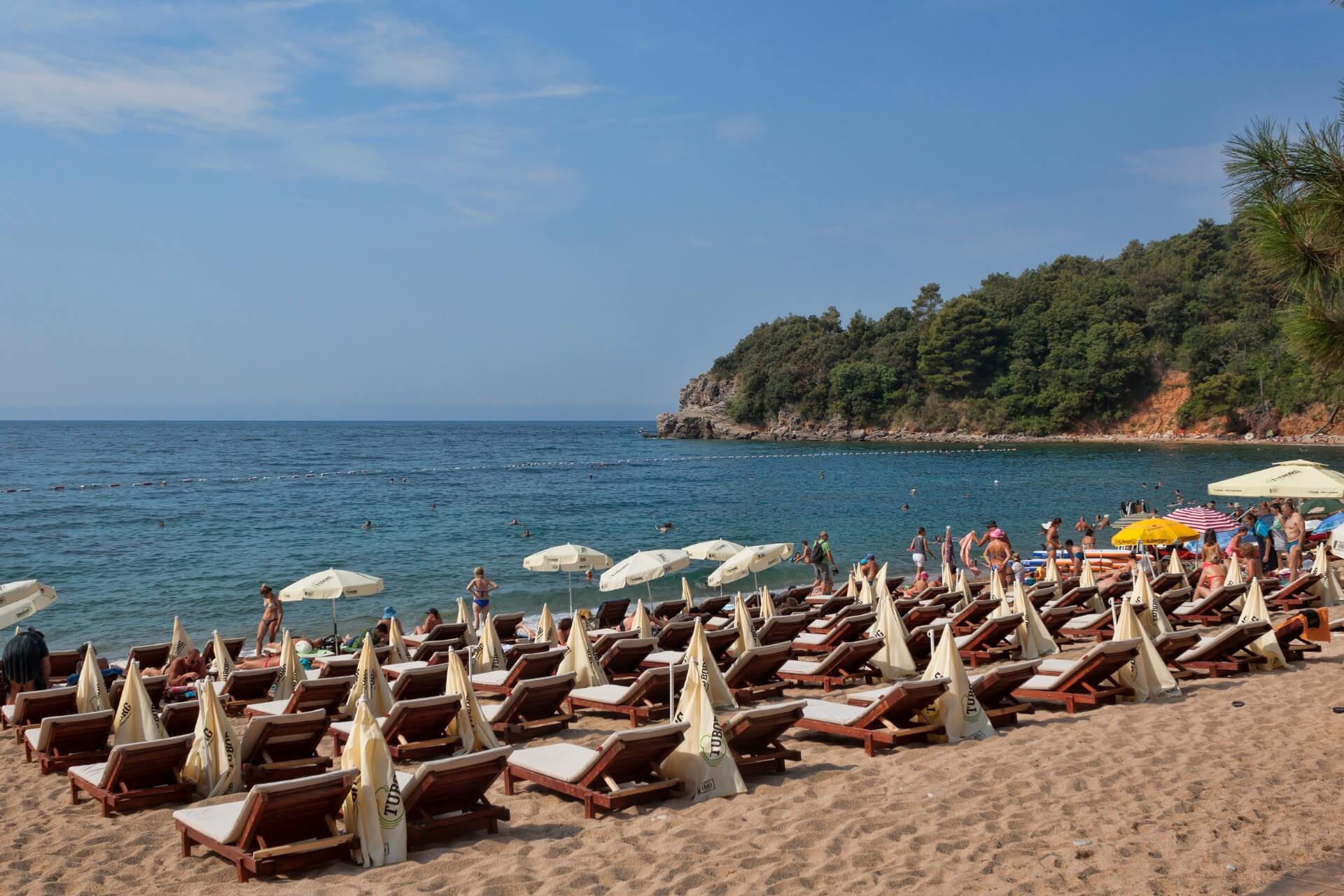
Near the Old Town, between the layered giants of rocks, lies a romantic piece of coastline. The rocks, like giants, parted, providing space by the shore for access to the water. Long ago, a Spanish sailor named Magrini was found here, and in his honor, two small swimming areas were named. They are separated by a narrow passage carved into the rock by locals.
Mogren 1 is 140 meters long, Mogren 2 stretches for 200 meters. Both territories belong to the Avala hotel, so an entrance fee is charged during the season. The local beauty, good sea, and sea views more than make up for all the costs. Rarely does anyone leave here unsatisfied. During the summer season, it is very crowded – full of vacationers. They are attracted by the proximity to the center, the picturesque location, and the fine-pebbled, sandy mixture covering.
It is easier to get here from the Old Town. On the other hand, the path passes through the twists of a narrow trail among giant boulders – romantic. Both beach sections are well-equipped, with changing rooms, showers, sunbeds, and umbrellas. The graceful figure of a gymnast, which has become a symbol of the resort, is installed at the entrance to the area. Legends have been woven about the monument, interpreting its origin in different ways.
Santa Maria in Punta Church
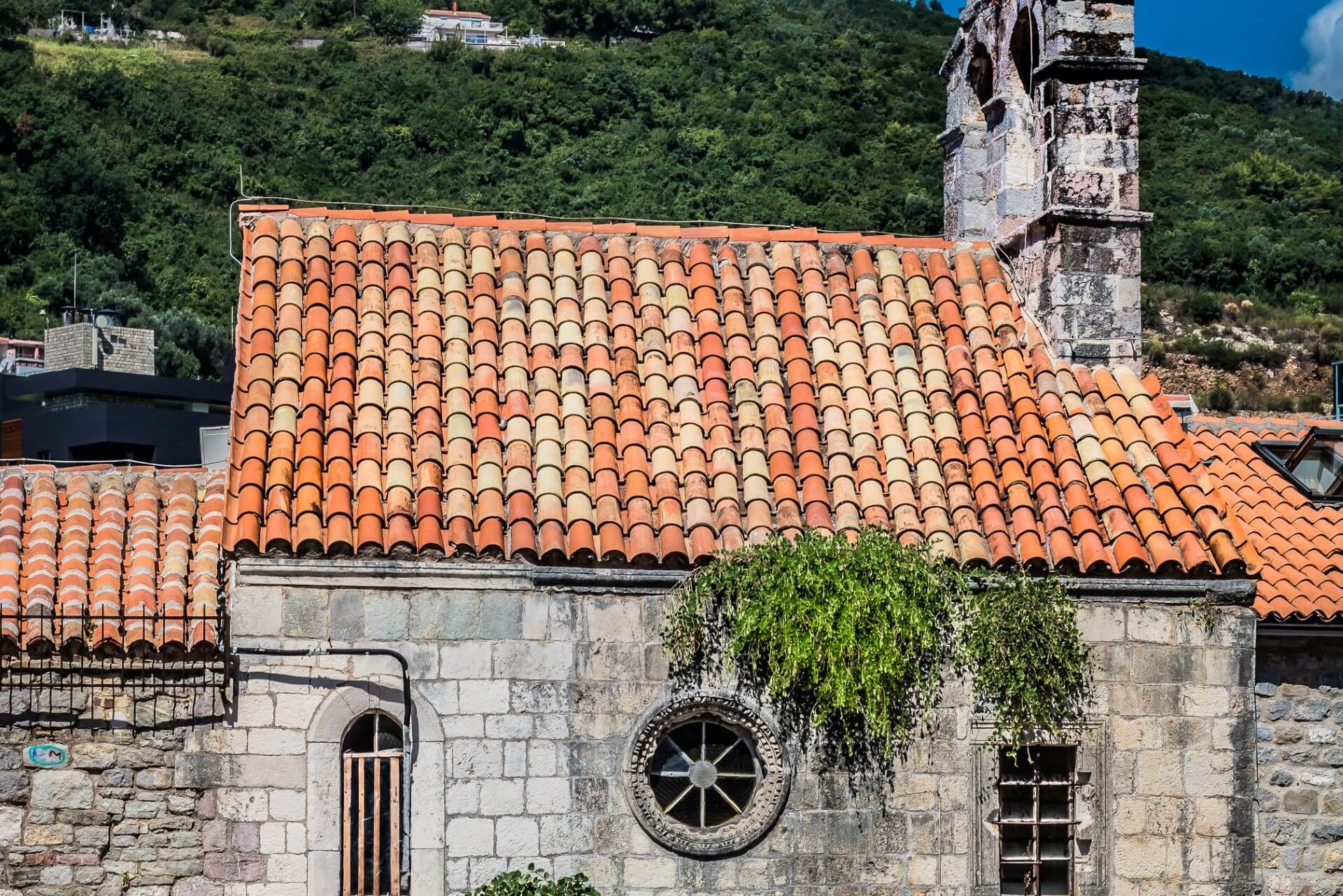
Today, on the site of an ancient sanctuary dedicated to Hercules, stands a fairly simple, even rather austere structure made of gray stone, crowned with a red tiled roof.
Seeing it for the first time, it is difficult to say whether this is a separate building or just part of the Citadel’s fortress wall, and saying that this building once served religious purposes is even harder. But it is – the Church of Our Lady is one of the oldest temples of the Adriatic, although today it is not used for religious ceremonies.
Originally, the church was built by missionary monks from the Benedictine order, and it remained under their patronage for almost five centuries until the fifteenth century when it was taken over by the Franciscans. This layering allowed the creation of a place unique in its beauty – but that beauty lies not in the stylistic features of the decoration (it is quite modest – poor).
Restored after the French conquests, Santa Maria in Punta Church has excellent acoustics, giving any sound an authentic sound, so today the ancient church vaults often become a venue for classical music events.
Here, too, the famous festival “Grad-Teatar” is held, bringing together under the ancient beams theatrical troupes, skilled puppeteers, readers, and musicians, filling the church halls with new colors.
St. Nicholas Island
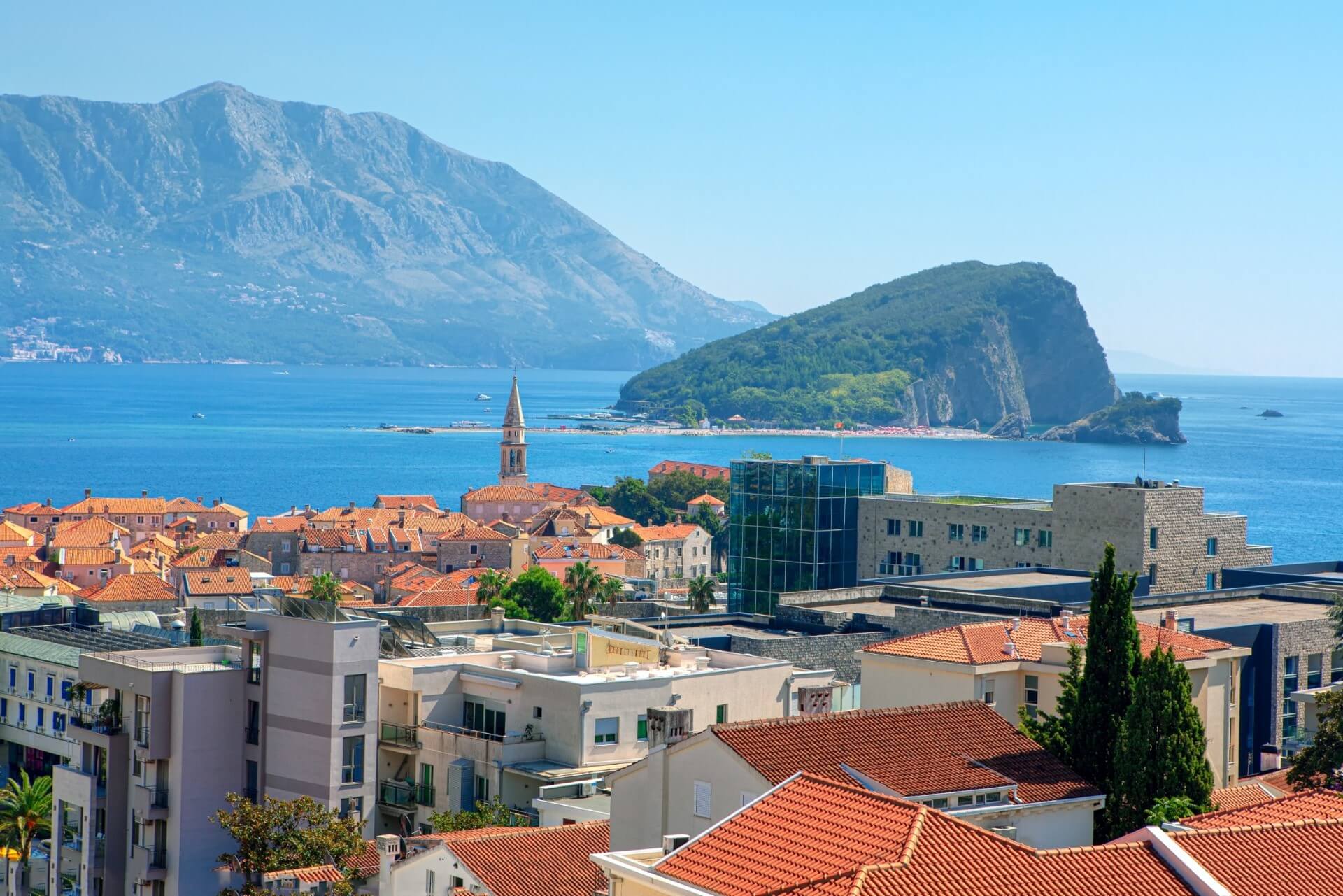
The sheer cliffs and lush greenery of St. Nicholas Island are well known to all residents of the city and those who frequently sail the Adriatic waters. This island has long been almost devoid of the detrimental enthusiasm of humans and is one of the most secluded and picturesque corners of true nature.
The island got its name, repeating the name of the local church, the ruins of which rest among the graves of crusaders kissed by the “black death” that raged in old Budva centuries ago. Notably, the island can only be reached by water, despite the fact that it is still connected to the mainland by a narrow strip of rocks leading to Slovenska Beach.
However, it is not recommended to use this “path” – it can be life-threatening and practically impossible at certain times. It is better to take one of the ferries or water taxis that run along this section of the coast. The cost of such a trip usually ranges around five euros depending on the season.
On St. Nicholas Island, you can not only take a series of impressive photos – the sea landscapes almost traditionally become some of the best, enjoy the beauty of the local plants and the loud cries of birds, immerse yourself in the world of somewhat frightening legends of past centuries, but also simply relax on one of the three beaches, ideal for those who feel uncomfortable being in a tight circle of strangers – the coastline of the island is very uneven – many small bays and grottoes, one of which has surely not yet been seen by anyone.
Old Town
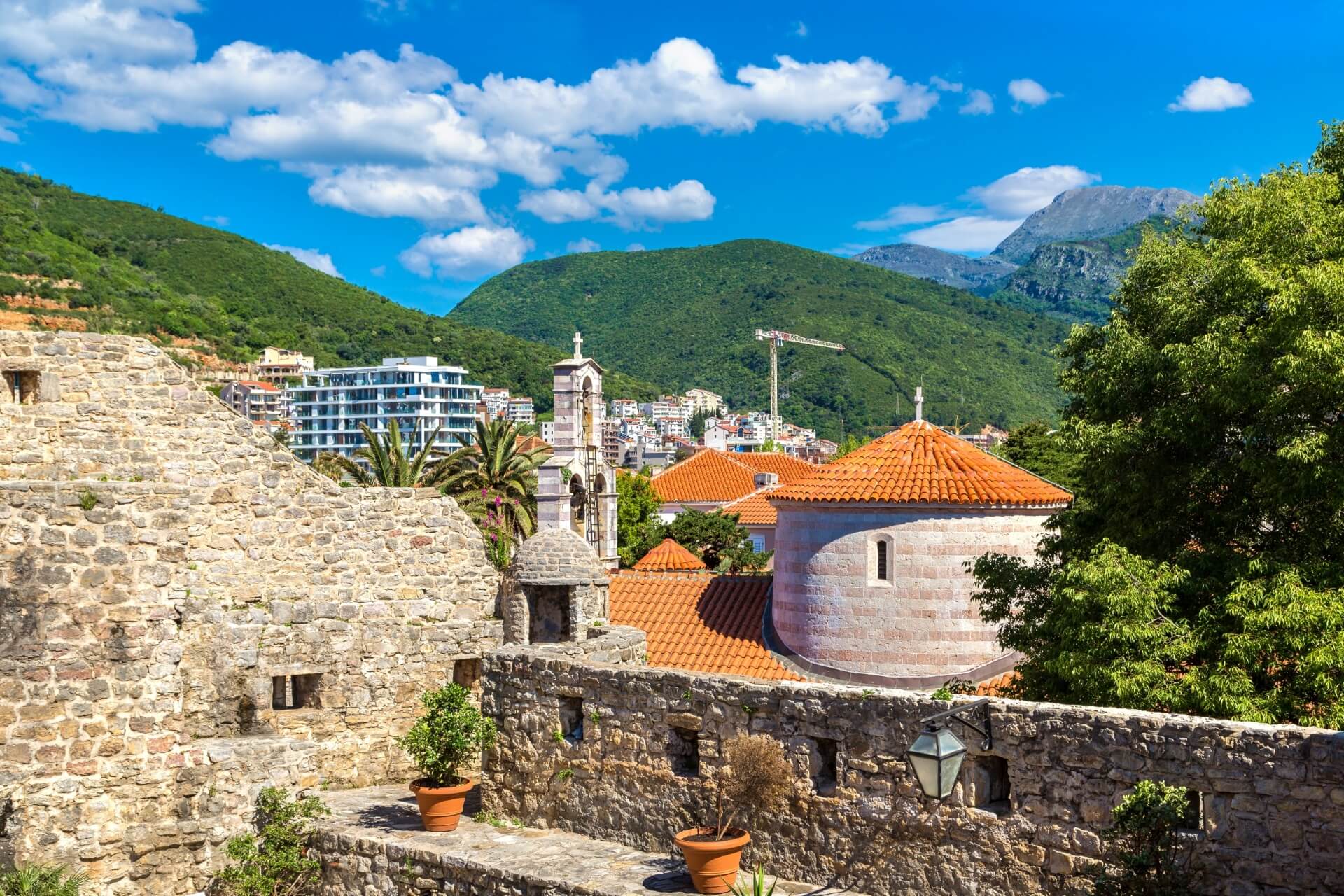
The Old Town is an island of medieval authenticity amidst more modern or even posh buildings in Budva. If you look at it from above, the bright tiled roofs and narrow streets will evoke nothing but almost childish delight – the fairy-tale town looks like a toy, but once you enter the world of ancient architecture in the Venetian style, walk along the streets supported by white walls, inhale the aroma of red geraniums and freshly laundered linen lazily flapping in the wind – the attitude changes. The walls no longer seem toy-like and indeed in places reach two meters thick.
The hallmark of the Old Town is the fortress walls of the Citadel, some sections of which have stood on the saltwind-swept coast for centuries. Notably, the Citadel complex includes not only fortifications but also the most beautiful churches, museums, and an entertainment center.
Five gates lead into the old part of the city, but only two of them are considered to be authentic historical structures. You can get here on foot from any corner of Budva – just follow the signs, which are found literally at every intersection, or simply take a taxi.
Usually, a trip along this route costs about five euros, which is quite a lot considering that most excursions conducted in the Old Town cost a maximum of two euros, so it is better to take a short walk, enjoying the contrasting views and spend the saved money on new discoveries.
Church of St. Sava
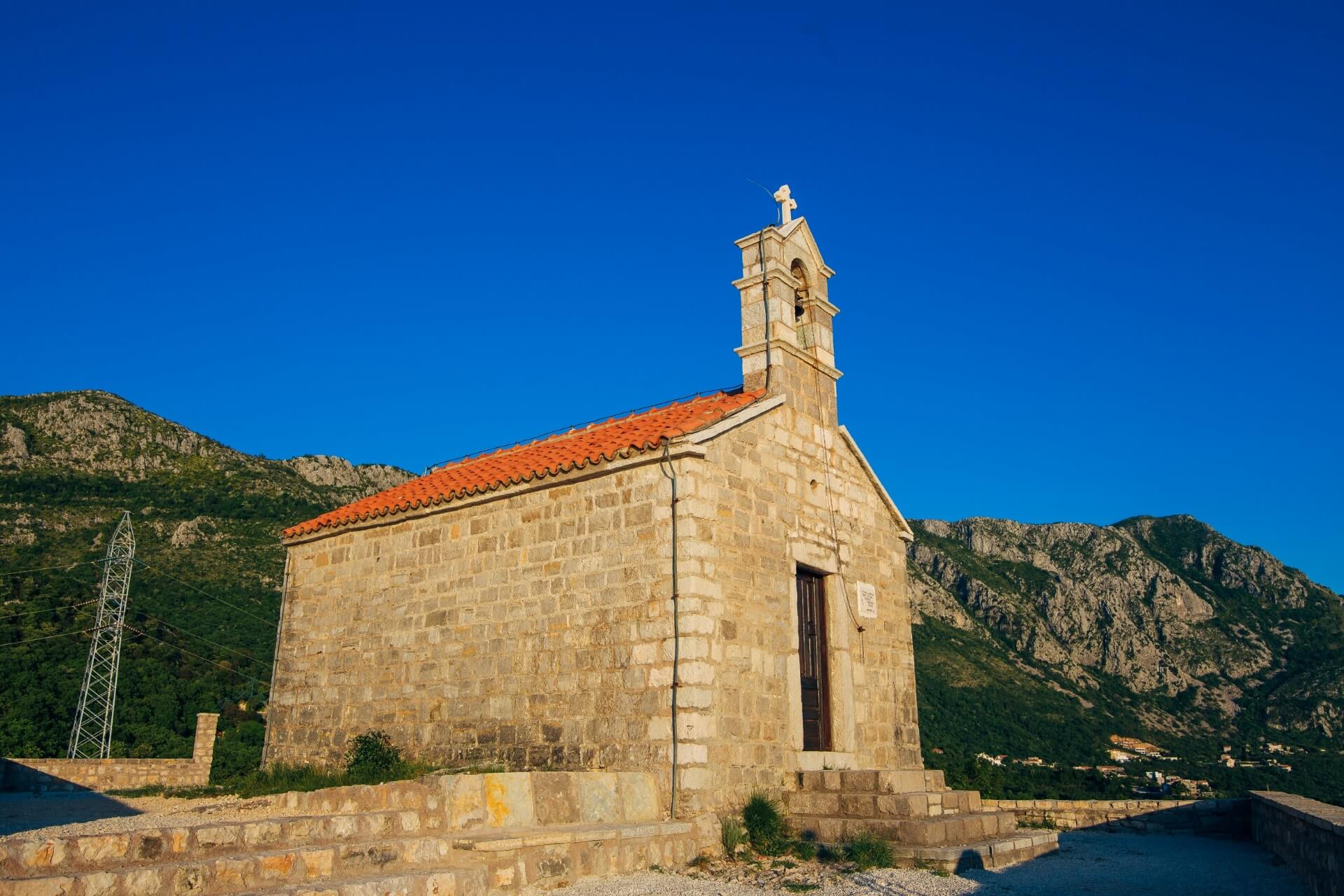
A unique landmark of the Old Town is dedicated to St. Sava of Serbia. According to legend, he is the founder of Orthodoxy in Serbia. The church in his honor was built in 1141 in the place from where Sava set off as a pilgrim to Jerusalem. Later the temple was taken over by the Franciscans. During the Venetian era, both Catholic and Orthodox rites were held in it. Since the 17th century, the temple became completely Orthodox.
A small (3×5 m) modest-looking structure is built into the fortress wall. It is made of gray and red stone. There is no cross above it, no bell tower, but their absence does not diminish the dignity of the temple. For local residents, this church is a sacred object. At one time, it housed a military arsenal, and after its liquidation, order was restored here.
Since then, the landmark has had the status of a significant monument. Today, no services are held in it, but it is open for visits. On the interior walls, fragments of 12th-century frescoes have been preserved – a valuable rarity. The church of St. Mary adjoins the temple of St. Sava, which is also worth seeing.
Jaz Beach
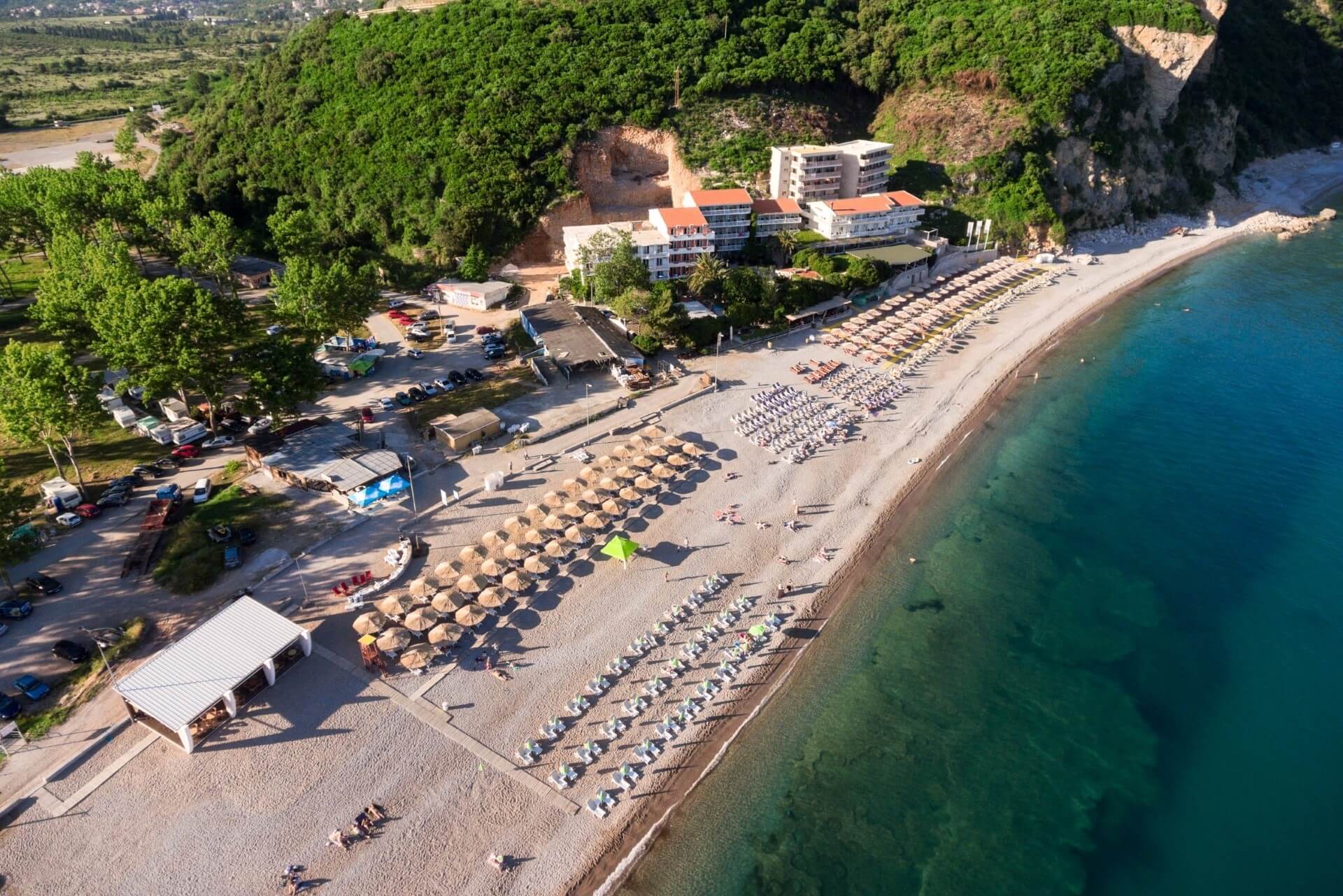
Among Budva’s beaches, Jaz stands out noticeably, actually consisting of two almost independent beach zones. It is highly popular among resort guests not only because it has hosted concerts by stars like the Rolling Stones but also because of its sandy beaches – a rarity for Budva – and the clean azure shade of the coastal waters.
“Jaz I” beach is a typical rocky beach with many boulders, gradually transitioning into fine pebbles and finally into golden sand. The beaches are equipped with all necessary amenities, and there is also the possibility to rent a beach umbrella and two sunbeds (about ten euros). It is best to head here before noon when the beaches are relatively free. Entrance to the beach is free.
Since Jaz is located somewhat away from the city, a walk there can be challenging – the narrow dirt road easily washes out after rain, and a walk on dusty ground on hot days will also not bring pleasure – especially since it will take quite a while. It is better to use the regular bus that departs from a stop in the vicinity of the Old Town. The Perla café can be used as a “beacon.”
Archaeological Museum
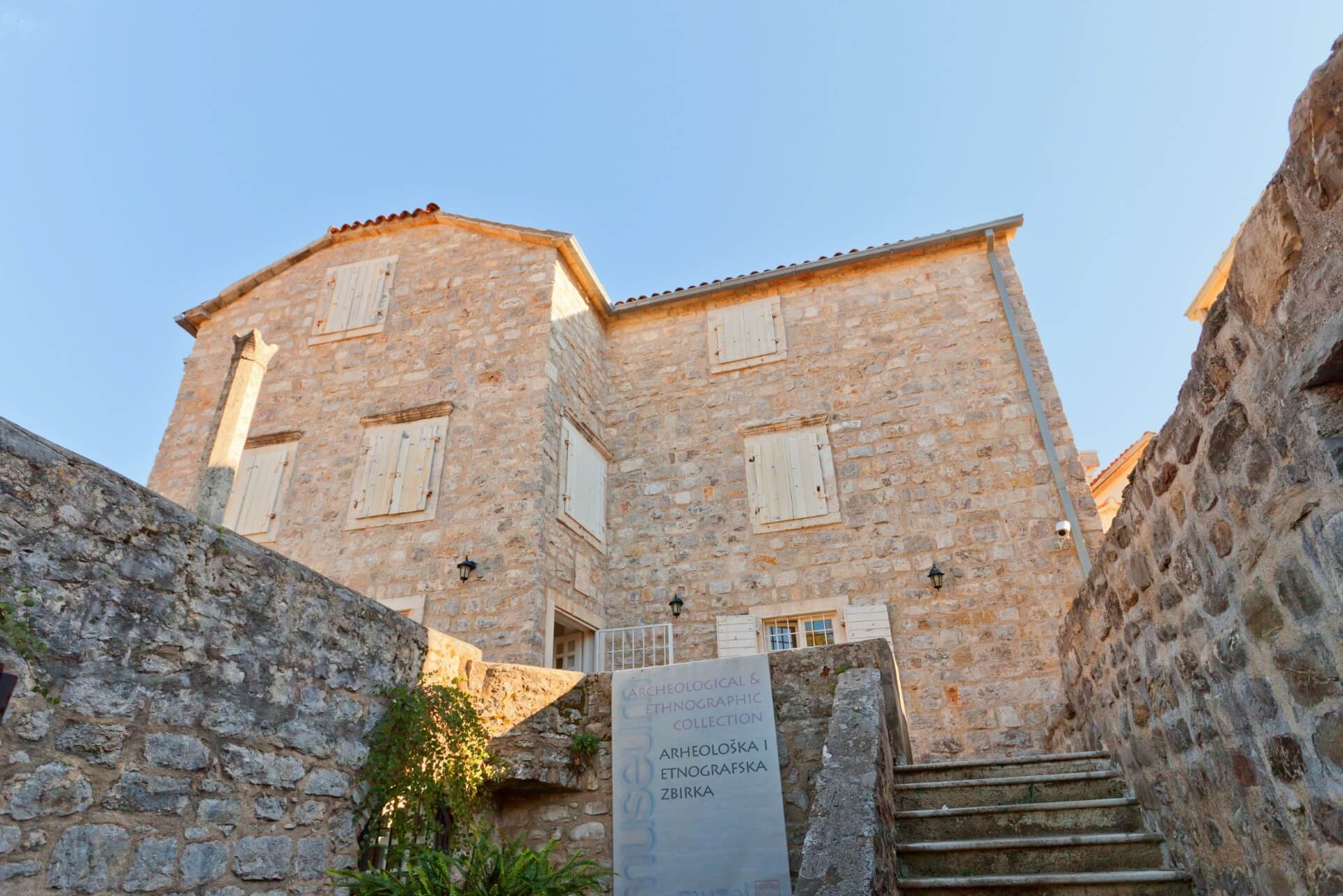
Budva, being one of the oldest “idols” on the entire Adriatic coast, has long turned into a kind of living embodiment of historical detachment – the sturdy walls of the Old Town, its red tiles, and purple geraniums – all this resembles a beautiful children’s coloring book for tourists and a complex scientific treatise for art and history enthusiasts.
Perhaps it is because of this almost habitual historical nature of this place that until the dawn of the twentieth century, there was no talk of opening a museum, but today the Budva Archaeological Museum has become too familiar a part of the landscape – without it, the city would lose part of its authentic charm.
The museum’s exposition – as expected – is full of more than notable exhibits belonging to various cultural layers, demonstrating the culture of Greece, Rome, and Venice, changed in favor of local color, whose “children” appeared in Budva at different times to linger here for a couple of centuries.
It is not surprising that the museum building is located in the historic part of the city, and the museum itself begins not with high walls but with the street, on which “remains” of ancient structures are scattered in seemingly chaotic order.
St. John’s Cathedral
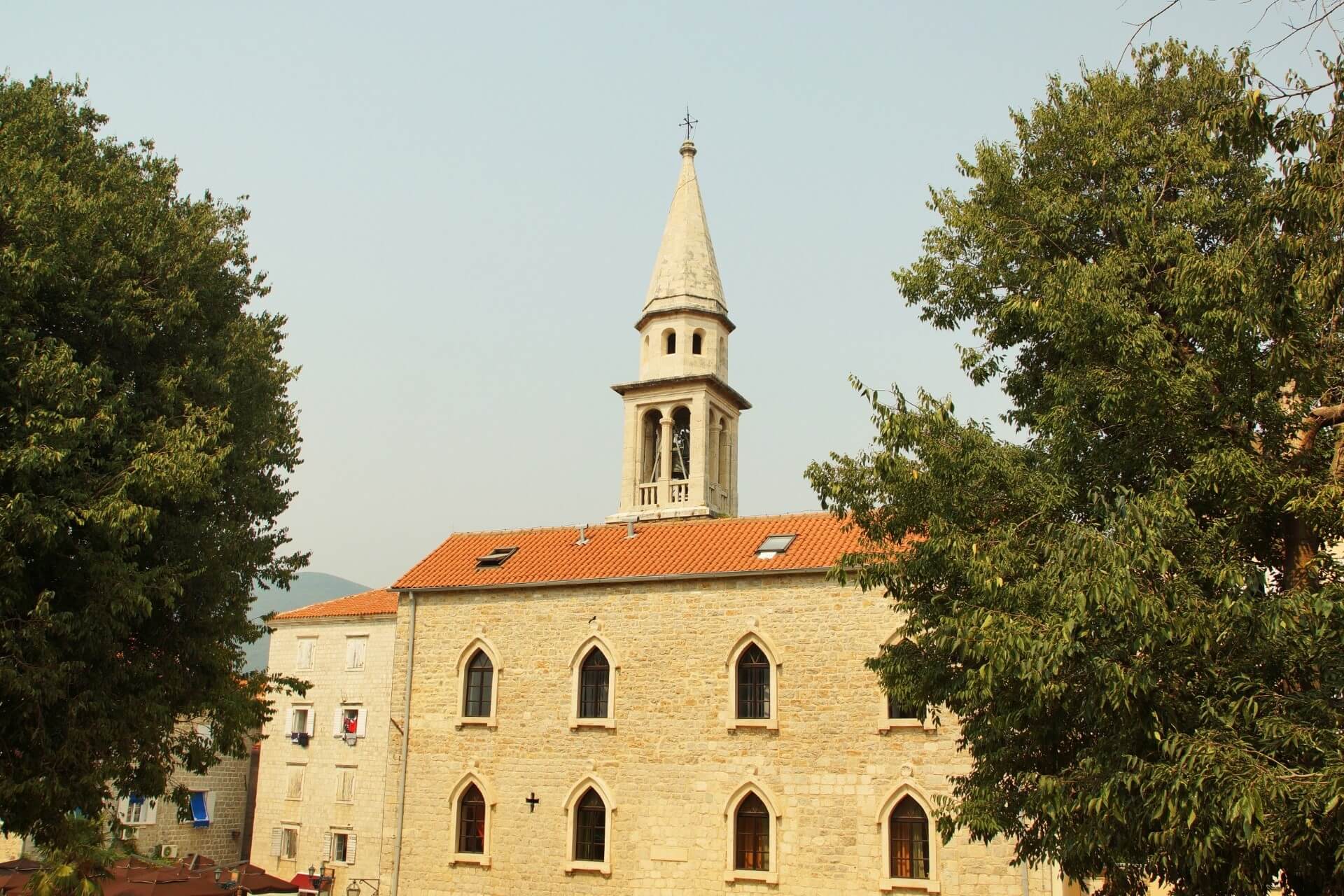
One of the main attractions of the historic center of Budva is located near the fortress wall. The high bell tower of St. John’s Cathedral is visible from afar as a landmark. The Gothic temple was built in the 13th century on the site of a 7th-century Christian church destroyed by an earthquake. But this structure also survived a destructive cataclysm, and in the 17th century, it was completely rebuilt.
In 1867, the religious object was supplemented with a bell tower. The strictness of the external decoration makes the temple’s appearance pristine. The restorers preserved the Gothic features: the rose window, the pointed windows, and the unplastered facade. The interior decoration is also characterized by restrained design. Below on the walls, fragments of ancient frescoes have been preserved, while the upper part of the walls is simply whitewashed.
The southern part of the cathedral is occupied by the altar of Our Lady of Health, whose image (12th-century iconography) is in the center. Next to it is the altar of the Holy Cross with a depiction of the Baptism of the Lord by Florian (1835). The northern altar, decorated with marble, is marked by the main relic of the cathedral – the 12-century icon of Our Lady of Ponta. On the mosaic fragment made of Murano glass (40 square meters) from the 18th century, John the Baptist is depicted during his sermon.
Budva Aquapark
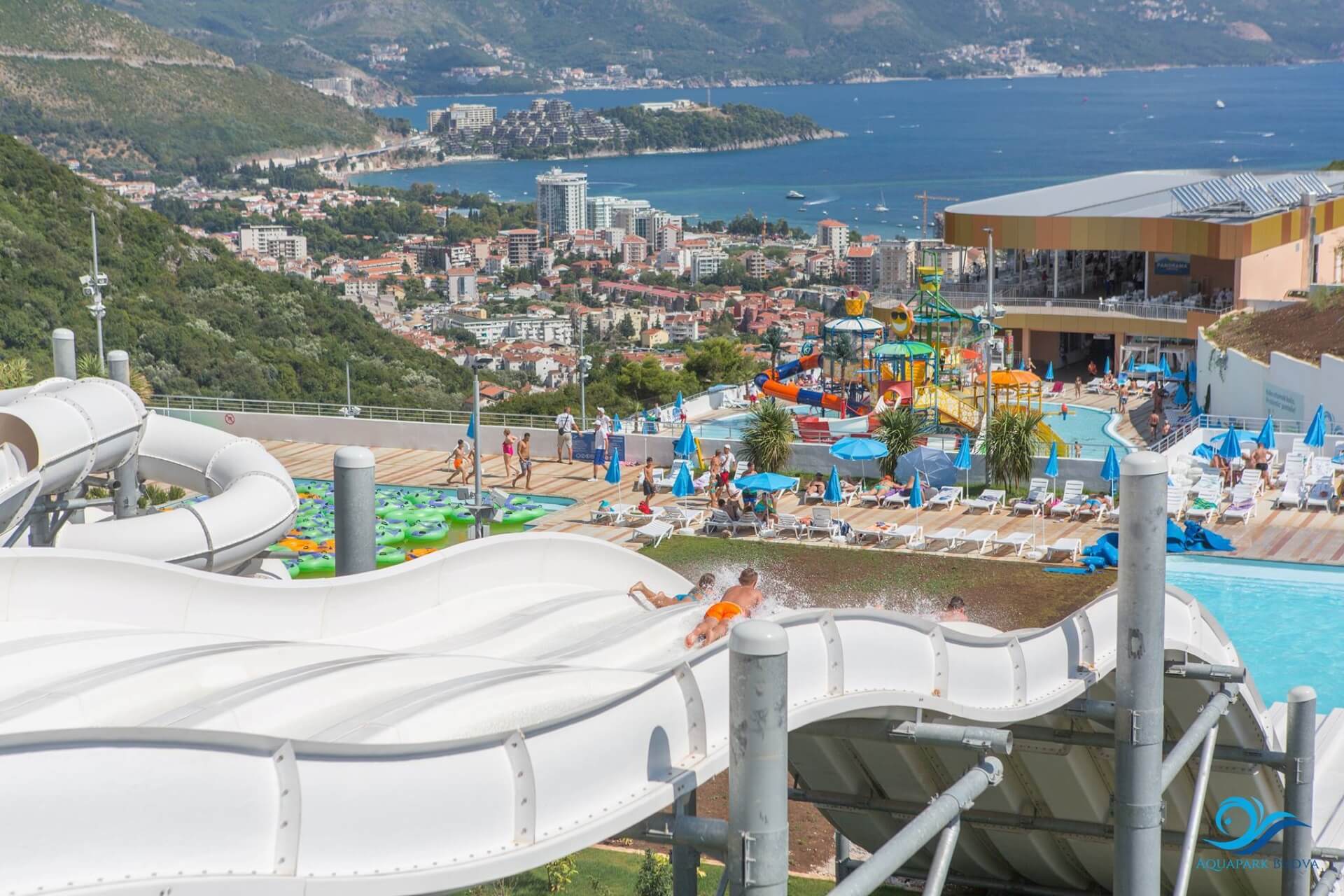
A highly popular modern attraction of the city, the Budva Aquapark, opened in 2016 and immediately became sought after by tourists and locals alike. The open aquapark, built by the Russian company Aquaterra, is located on an area of 40,000 square meters. It is situated on a mountain next to the Top Hill nightclub. The territory can accommodate up to 6,000 people per day. The stunning views of the sea coast that open up from here complement the interesting stay.
The owners made the space as convenient as possible. Numerous sunbeds allow all visitors to use them. The 3-level terraces accommodate a large number of attractions. The lower terrace is designed for family relaxation with children. It is equipped with children’s attractions, which were installed following the principle of safety. While children are frolicking, parents can watch them sitting on sunbeds.
Visitors climb the first upper terrace via extreme slides. Here are located amazing labyrinths in the form of pipes, chutes, and spacious pools. One of them even has a bar counter – you can order a drink right in the water. The third terrace houses the entrances to the slides and a large wave pool. For adult thrill-seekers, there are seven slides: Tornado, Rafting, Hydro-pipe, and others. Among them is the high-speed slide – the large Kamikaze.
Gallery of Contemporary Art
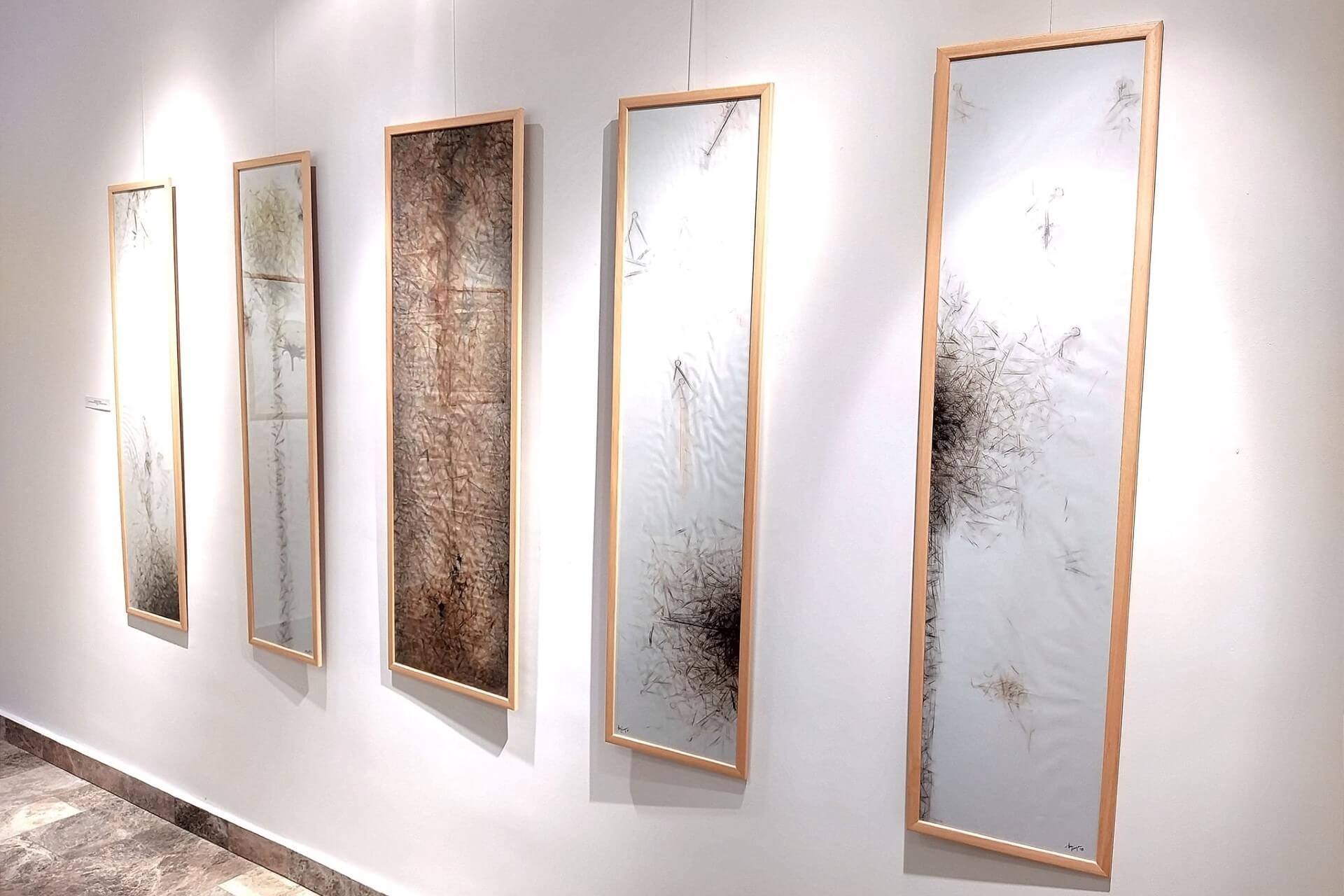
The necessity of an exhibition pavilion to display art objects in Budva arose from the annual meetings of artists held here. Each of them left one of their works as a token of gratitude to the city. To accommodate them, the Gallery of Contemporary Art was opened in November 1972. At the ceremonial exhibition in honor of this event, masters of contemporary visual art from various European countries and Japan gathered.
Tabuchi, Lindstrom, Bradley, Jusselin, Gille, and others donated one of their works to the Gallery, creating the “Modern Expressionists” collection. Throughout its history, the Budva Gallery aimed to present the works of the best contemporary painters. Today, paintings by artists from various countries are exhibited in its halls. Here are canvases by the Mexican Andreas Salgo, the Egyptian Salah Taher, the Spaniard Oscar Estruga, the Serb Nikola Graovac, and others.
The range of genres and styles of works is extraordinarily wide: oil, watercolor, graphics, canvas, sculpture, photography (a total of about 400 items). Most of them are works by masters of the second half of the 20th century and the beginning of the 21st century. The Gallery is named after the native of Budva – the artist Jovo Ivanović, who headed the institution for 30 years.
Kosmač Fortress
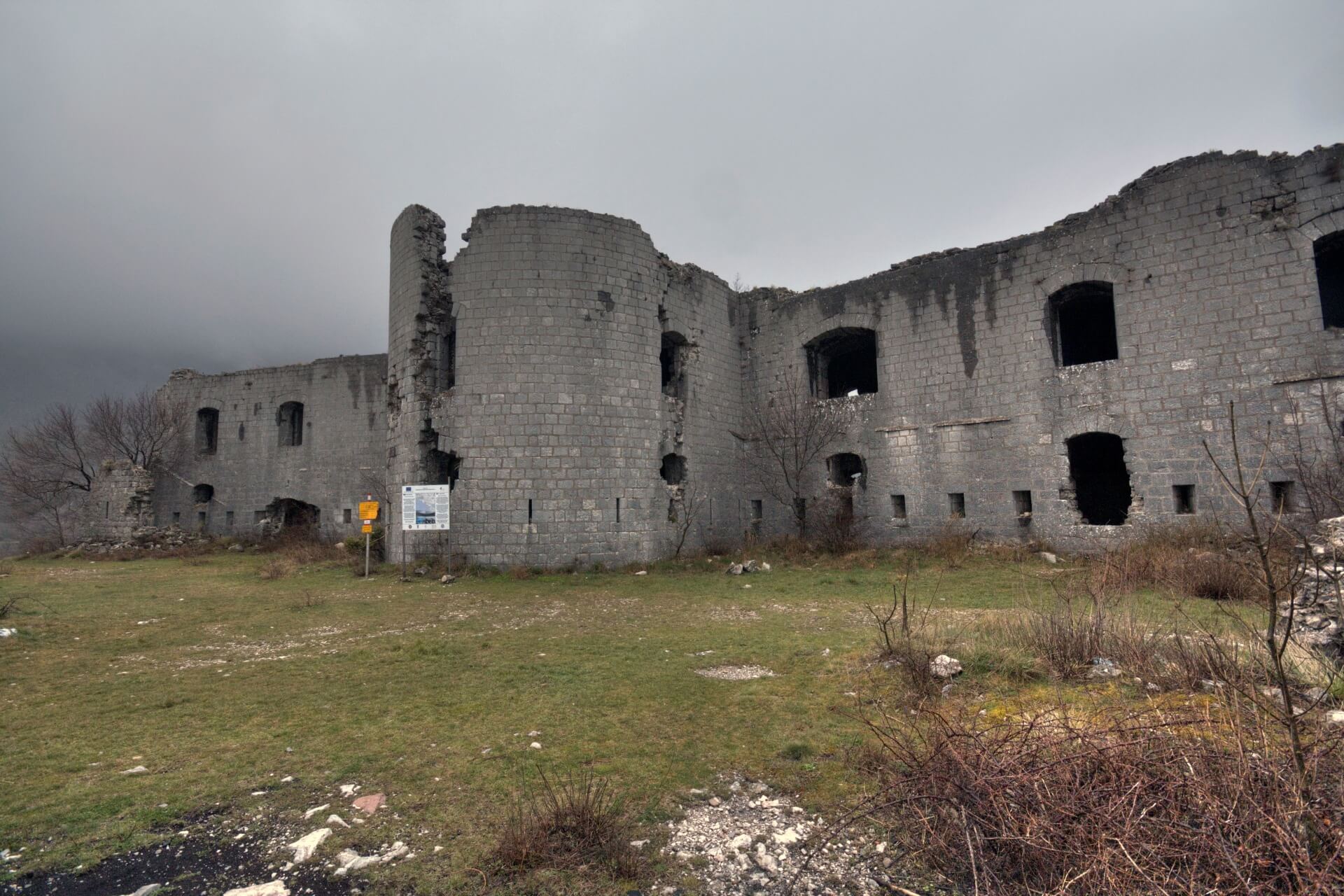
This not-so-popular tourist attraction is located near the village of Brajići. If you travel from Budva to Cetinje, you can see the Kosmač Fortress from the bus window. The historical monument of military architecture from the 19th century is located on the hill of the same name (800 meters above sea level). The fortress, built using the latest technologies of that time (1841-50), became a kind of border between Austria and Montenegro.
The hill offered an excellent view of the surrounding area, making Fort Kosmač an important strategic point. At different times, it was owned by Austrians and Italians. Visiting the fortress turns into a romantic journey among the stunningly beautiful views on both sides of the road. One can fully enjoy the lush richness of the flora and the blue peaks of the mountains.
A narrow road leads to the fort, driving on which is not safe. There is a pedestrian path with signs – many prefer to climb on foot. The fortress is a 2-story complex of round bastions with a basement. Traces of military attacks are visible. The right wing and the central bastion suffered the most.
The 1979 earthquake added to the destruction. The window openings of the structure and the shooting tower are best preserved. The construction technology ensuring the defensive power of the fortress can be determined from the remaining walls. Visiting this place evokes thoughts of the brutality of war, against which stones are powerless.
Sveti Stefan
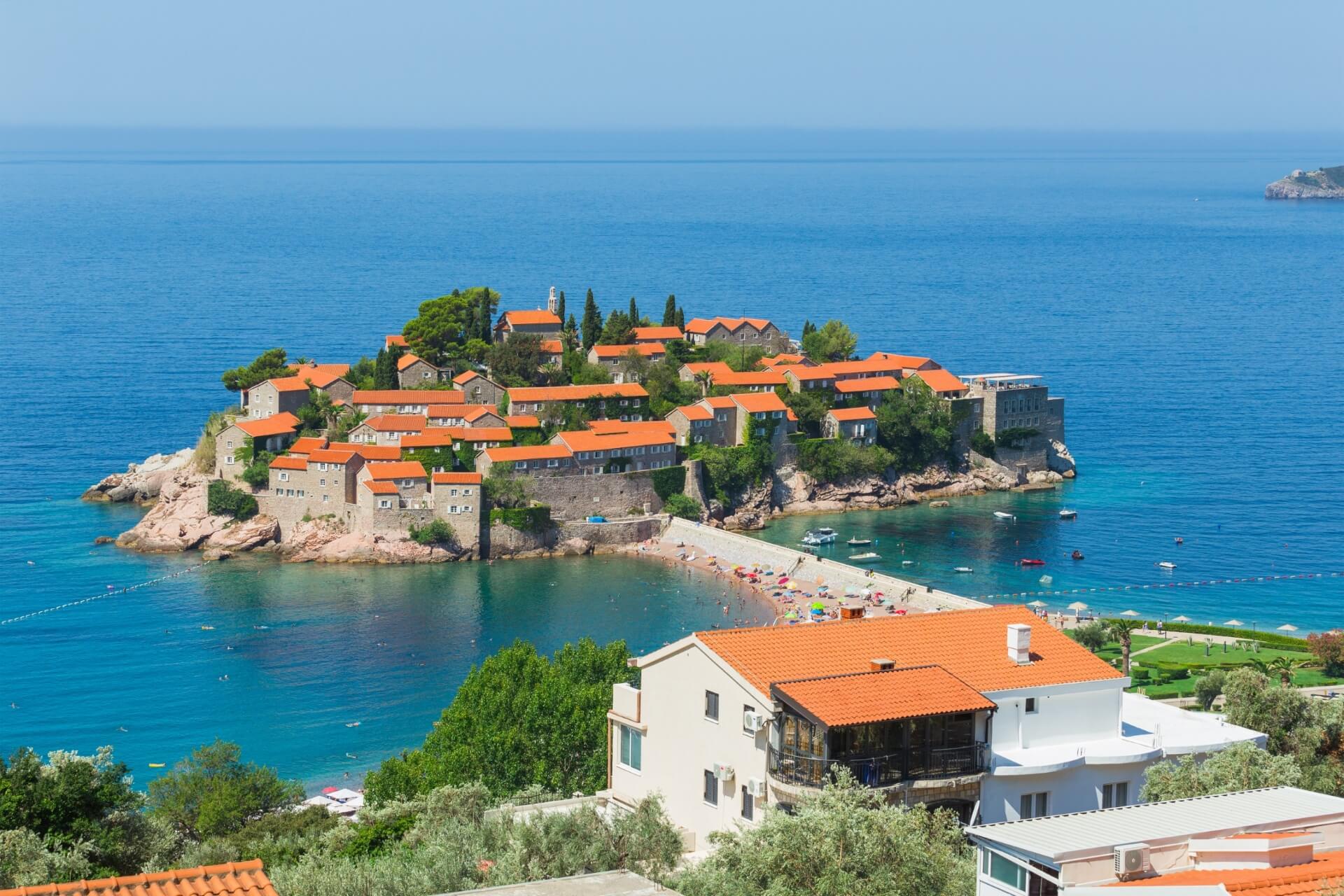
The Budva Riviera has its own paradise corner where the world’s elite flock to rest. Celebrities from the world of cinema, show business, politics, and art have been noted here. Several decades ago, the modest fishing village on the Sveti Stefan peninsula could not have dreamed of turning into an elite place.
Today, the entire territory, located 500 meters from the Adriatic coast, is one huge hotel. The medieval fishermen’s houses, converted into luxury hotels, have retained their authentic appearance. Designers tried their best to preserve their medieval color, giving the resort a special charm.
Not everyone can afford to stay in the luxurious interiors of local rooms. But anyone can come here to see the wonders of civilization. Everything is in harmony here, thanks to skillful planning. Wonderful pebble beaches (there are two), clean, clear sea, and stunning nature fully match the perfection of everyday comfort.
One beach is public, the other is private, belonging to the hotel. Tourists are brought here by boat, with a stay of 2 hours. During this time, you can swim, explore the resort’s beauties, and take a walk in the pine forest, breathing in the pine air. Drinks and food are sold in tents on the shore.
Mount Čelobrdo
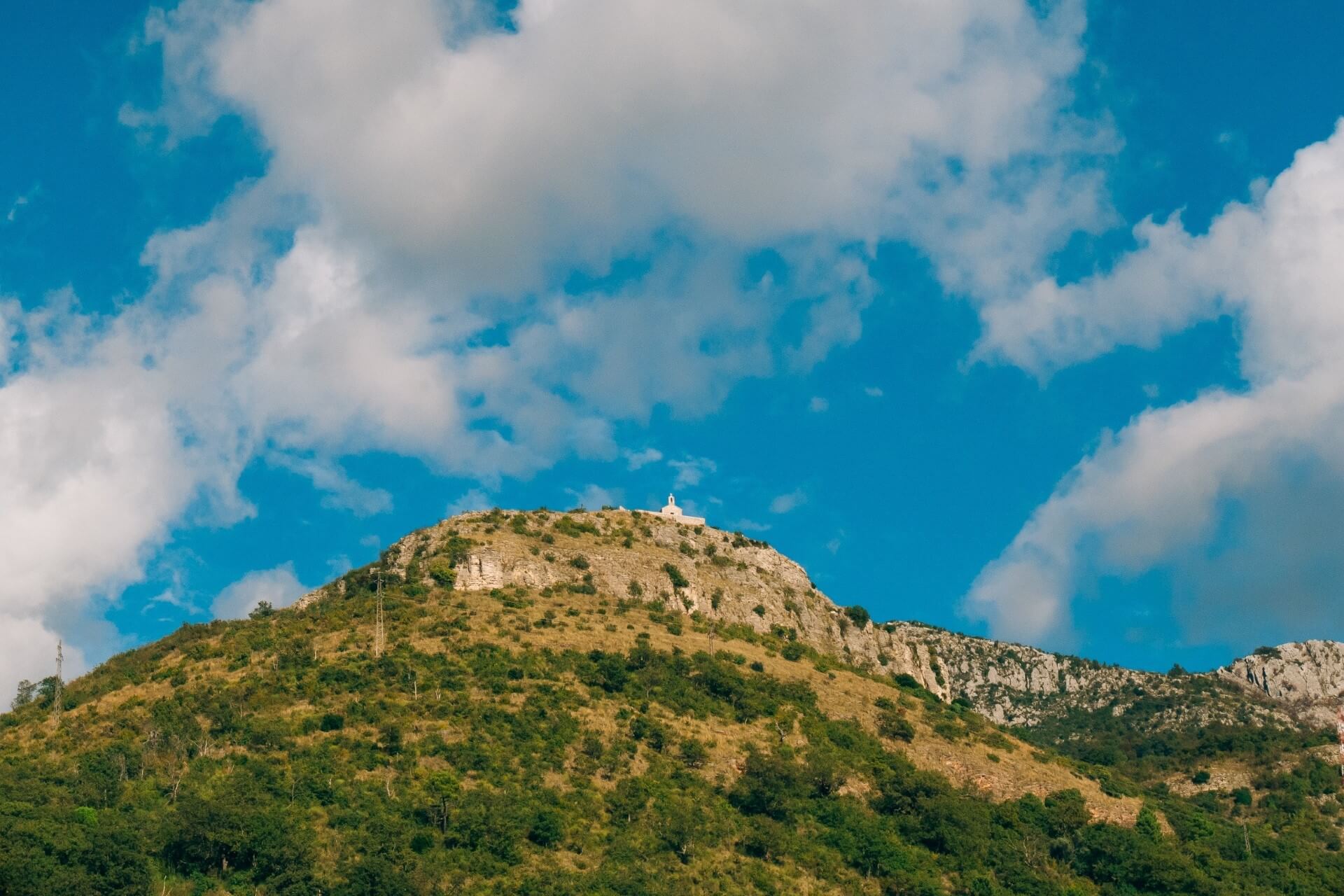
Tourists visiting the Praskvica Monastery inevitably climb Mount Čelobrdo. This natural observation deck offers a view of the Budva Riviera. The panorama opening from above is breathtaking. The turquoise expanse of water, bordered by a necklace of beaches, the island of Sveti Stefan, and the green caps of forests – a divine picture.
From the monastery to Čelobrdo leads a stone road that people walk on foot. According to legend, it was built by the monk Egor Strogoff, who spent 10 years on it. Even higher is the women’s monastery Rustovo, where there is a temple of the Holy Martyrs Romanov. An unforgettable journey here can be made by car. First, you need to drive along the Pržno – Sveti Stefan highway, then, before the fork, turn off the highway and drive 2 km towards the village of Čelobrdo.
There is a monument to the hero-warriors that tourists do not bypass. Traditionally, they stop at a spring with sweet-tasting spring water. The entire path to the mountain is decorated with enchanting landscapes. But the most breathtaking views open from Mount Čelobrdo. The botanical garden Miločer, the towns of Pržno and Bečići are visible. In the evening, you can watch the magnificent sunset from here.

